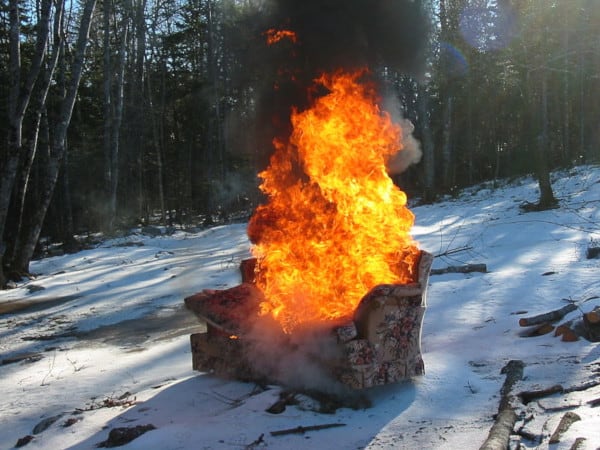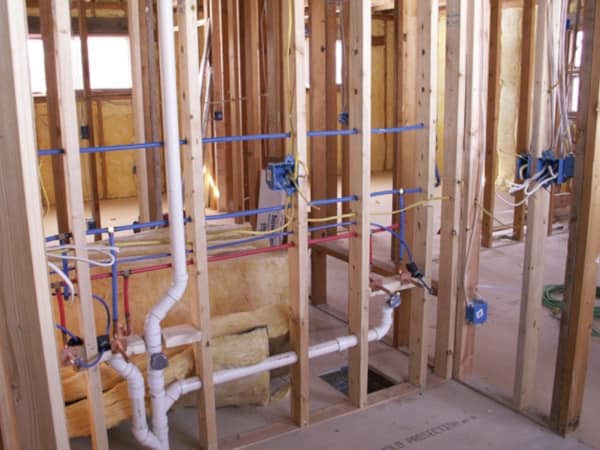Fire sprinklers for storage feature prominently in the technical changes made to NFPA’s latest edition, while air compressors and other components see significant revision
In the first installment of QRFS’s two-part series on the changes to the 2019 edition of NFPA 13: Standard for the Installation of Sprinkler Systems, we explained how to navigate this thoroughly reorganized document and looked at technical changes pertaining to residential sprinklers in NFPA 13 systems:
Significant Changes to the 2019 edition of NFPA 13, Part 1
NFPA 13 also saw revisions impacting dry-pipe systems, storage sprinklers, and working plans. In this article, we take a look at those technical changes to the 2019 edition and place them in context with public comments submitted to the fire safety organization.
If you’d like, you can click here to browse our selection of commercial and residential fire sprinkler heads and system components instead.
A handful of technical changes hide inside a reorganized standard
Many changes in the 2019 edition of NFPA 13 simply provide clarification, delete redundancies, or align NFPA 13 with other technical standards. Technical changes, while present, are relatively few and far between. This appears to be intentional; Raymond A. Grill, chair of the NFPA 13 Technical Committee on Sprinkler System Installation Criteria, mentioned that committees made efforts to limit the number of technical revisions, focusing instead on reorganizing the standard.
Still, the 2019 edition of NFPA 13 features several technical changes involving storage sprinklers, system components, and documentation including:
- Relaxed and revised requirements for Early Suppression, Fast Response (ESFR) sprinklers
- Criteria for 25.2 K-factor sprinklers and spacing guidelines for in-rack storage sprinklers
- Updated tables for Control Mode Specific Application (CMSA) sprinklers and wedge anchors
- Automatic control valves permitted
- Common-sense requirements for dry-pipe air compressors
- A new exemption added for concealed combustible spaces
- Clarified requirements for working plans
We’ll review each of these in turn in the following sections.
NFPA recognizes wider uses for ESFR sprinklers (14.2.4) and adds a distance from ceiling requirement (23.7.4.1)
Changes to the 2019 edition allow for the use of early suppression fast response (ESFR) fire sprinklers under obstructed combustible construction in NFPA 13 systems. Prior editions limited their use to unobstructed and noncombustible spaces only. This revision to section 14.2.4 brings NFPA 13 into alignment with guidelines from FM and manufacturers’ findings on the suitability of ESFR sprinklers for use around bar joists, beams, and girders.
Section 23.7.4.1 adds a new limit to the use of ESFR sprinklers protecting exposed expanded Group A plastics. These materials, which include mattresses, foam plastic containers, and cushioned furniture, form especially hot, hard-to-fight fires that spread quickly. Some proposed changes to NFPA 13 recommended allowing ESFR sprinklers fighting these fires to be installed as low as 18 inches from the ceiling. Instead, the final standard relied on recent testing of ESFR sprinklers to settle on a 14-inch deflector-to-ceiling limit for ESFR sprinklers covering these Group A plastics.

Section 25.8.3 adds criteria for extended coverage K-25.2 pendent in-rack sprinklers while section 25.5.2 articulates new limits for spacing of in-rack sprinklers
Some Group A plastics and Class I through Class IV commodities – classifications covering everything from noncombustible products on wood pallets to combustible rubber and PVC – require more protection than an overhead sprinkler system can provide. In-rack sprinklers, along with horizontal barriers, can provide that extra protection. Using criteria based on full-scale fire tests, section 25.8.3 provides installation requirements for pendent in-rack sprinklers with a 25.2 K-factor – the largest orifice size yet.
The 2019 edition of NFPA 13 also changes the horizontal spacing requirements for in-rack sprinklers, in some cases enlarging the 8’ limit prescribed in the 2016 edition.
From the 2019 edition of NFPA 13
25.5.2.1.3 For rack storage of rubber tires, the maximum allowable horizontal spacing of in-rack sprinklers shall be 8 ft (2.4 m).
25.5.2.1.4 The maximum allowable horizontal spacing of in-rack sprinklers for Class IV and Group A plastic commodities in miscellaneous, low-piled, and rack storage shall be 10 ft (3.0 m).
A public comment provided to the NFPA notes that this change clarifies existing guidelines, which already seemed to allow for ten-foot spacing on some sprinklers placed in longitudinal flue spaces – the space between commodities on racks placed back-to-back. Notably, sections throughout the new edition still require 8’ spacing across the width for racks with multiple rows.
The 2019 edition updates tables for CMSA sprinklers (chapter 22) and wedge anchors (section 18.5)
Control mode specific application (CMSA) sprinklers produce large droplets at low pressures to provide improved fire penetration and control of some high-challenge fire hazards. Full-scale fire tests of CMSA fire sprinklers show that 25.2 K-factor heads can protect palletized and solid-piled storage of Class I through Class IV commodities. Changes to tables 22.2 through 22.5 in NFPA 13 2019 reflect this new listing data, providing additional design criteria for CMSA sprinklers in storage applications.

Other tables in the 2019 edition of NFPA 13 have been changed, including those specifying the maximum load of wedge anchors in pipe-hanging applications. These standards took effect when the NFPA issued a tentative interim amendment (TIA) roughly two years before the new standard’s release. The tables in section 18.5 bring the new edition into accord with recent standards from the American Society of Civil Engineers.
Section 16.9.4 introduces automatic control and indicating valves to NFPA 13
The addition of Section 16.9.4 to the 2019 edition of NFPA 13 paves the way for the use of automatic control and indicating valves in fire sprinkler systems. The public comment proposing the change explains:
Technology now allows for automated valves to be used in systems. These requirements for these valves need to be included in this section. The valve must indicate whether it’s open or closed, or a means of supervision that indicates its position must be provided just like a standard control valve. If an automated valve is provided it still needs to be able to be opened and closed manually.
If they can prevent even a fraction of the sprinkler system failures caused by closed control valves, these valves could save lives. In the first draft ballot, the Technical Committee on Sprinkler System Installation Criteria passed this change with near-unanimous approval.
But an identical provision faced more resistance when presented to the Technical Committee on Standpipes during revisions of NFPA 14: Standard for the Installation of Standpipe and Hose Systems. Three members voted against the resolution, expressing fears that automated valves might lead to more closed valves – and more system failures. In a comment accompanying her negative vote, committee member Rita Neiderheiser wrote:
So the implication of this code change – if it’s based on an actual problem – is that it would solve for human error. Which means to me that it would have to be a computerized system, where code, computers, and a network would be used to operate the valve. If this is the case, then we need far more information about that entirely new system to be able to determine whether we are capable of writing code to address it. If this is not the case, it’s not at all clear why we would replace what we have now with essentially more of what we currently have (the ability of a human to incorrectly operate the valve).
In the end, both the 2019 editions of both NFPA 13 and NFPA 14 incorporated these changes, making new technologies available to installers of NFPA-compliant systems.
Section 8.2.6.6.5 adds that air compressors serving dry-pipe sprinkler systems must be permanently installed in a way that accords with the National Electrical Code
Pipes in a dry-pipe sprinkler system contain compressed air until sprinkler heads activate. Some systems use automatic air compressors, while others use a manually-operated system or compressed gas in a cylinder. Additions to the 2019 version of NFPA 13 state that dry-pipe systems’ air compressors should be installed in accordance with NFPA 70: National Electrical Code – with one important change.
From the 2019 edition of NFPA 13
8.2.6.6.5 Where an air compressor is the dedicated air supply, it shall be installed in accordance with NFPA 70, Article 430.
8.2.6.6.5.1 The disconnecting means for an automatic air compressor shall not be a general-use light switch or a cord-and-plug connected motor.
While the use of light switches and cord-and-plug connected motors work in many applications, a flipped switch or pulled plug can cause an inadvertent decline in pressure and “false trips” when used with a dry pipe sprinkler system. Further, electricians or system installers repairing these compressors can’t properly lock and tag compressors disconnected by a “general-use light switch.” The 2019 edition brings these common-sense practices from the world of electrical contracting to fire protection.
Cavities within unsprinklered wall spaces added to the exemptions from minimum area of sprinkler operation in section 19.3.3.1.5.2
After sprinkler designers assess how hazardous a space is, they determine how much water to use protecting it. These hydraulic calculations can be determined in various ways, including with the use of density/area curves that provide a minimum density, in gallons per minute per square foot, of water to release in a given area.
In some cases, designers using this method may permissibly leave certain areas unprotected. Many of these spaces are concealed spaces created by building construction, such as the area between a ceiling and a rooftop. In the 2019 edition, NFPA 13’s list of exemptions for combustible concealed spaces grows slightly larger, formally excluding wall cavities created where drywall or other wall material attaches to wooden studs.

Requirements for working plans clarified in section 27.1
While previous editions required the submission of sprinkler designs to fire authorities – and even provided a detailed list of items to include – they had no official minimum requirements to include with the submittal package. Changes to the 2019 edition of NFPA 13 formalize the minimum requirements for working plan submittals.
From the 2019 edition of NFPA 13
27.1.1.1 Working plan submittals shall include the following:
(1) Working plans of the system(s), per 27.1.3
(2) Hydraulic calculations where systems are required to be calculated
(3) Data sheets for the system components where required by the authority having jurisdiction
(4)* Signed owner’s certificate27.1.1.2 Submittals shall be permitted to be in electronic format when approved by the authority having jurisdiction.
27.1.1.3 A copy of the approved plans shall be given to the owner or owner’s representative.
The new edition also revises the 46-item list guiding the development of working plans. When applicable, designers must now include:
- Zones of influence used in calculations for seismic bracing indicated on plans.
- Name, address, and phone number(s) of contractor.
- Ceiling/roof heights and slopes not shown in the full height cross section.
- Make, type, model, and size of backflow prevention assembly, and means to forward flow test at system demand.
The new list eliminates some redundancies and helps reviewers guarantee the accuracy of seismic calculations. These items also ensure that plans include the backflow prevention assemblies often required for NFPA 13 systems.
Stay code and standards-compliant with knowledge and products from QRFS
This concludes our two-part series on the changes to the 2019 edition of NFPA 13. These technical changes recognize new applications for existing technology, make way for new products, and bring a few other modest improvements to more than a century’s worth of fire code.
If you need to purchase items for your NFPA 13-compliant fire sprinkler system, click here to browse our wide selection of commercial and residential fire sprinkler heads and system components. Take a look at our ductile iron control valves, 16.8K ESFR fire sprinklers, and pipe-hanging anchors selected to keep you under budget and up-to-code.
Questions? Call us at +1 (888) 361-6662 or email support@qrfs.com.
This blog was originally posted at blog.qrfs.com. Let QRFS keep you informed and up-to-standards – like us on Facebook at Facebook.com/QuickResponseFireSupply or follow us on Twitter @QuickResponseFS.



Any NFPA guideline for DRY ESFR Sprinkler system for normal temperature (25c to 35c) warehouse ?
The installation guidance for all dry systems is contained within NFPA 13. We do not explicitly know if any of the 2019 changes affect these systems without significant research. If you have any specific questions, we encourage you to try our Ask a Pro service, where a fire professional can tackle them!